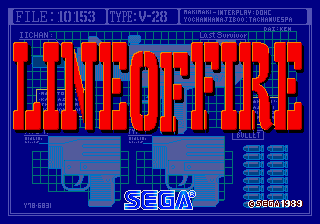Line of Fire
From Sega Retro
| Line of Fire | |||||
|---|---|---|---|---|---|
| System(s): Sega X Board, Amiga, Amstrad CPC, Atari ST, Commodore 64, ZX Spectrum | |||||
| Publisher: Sega U.S. Gold | |||||
| Developer: Sega Creative Materials, Uncle Art (music), Tiertex (protection) Creative Materials | |||||
| Genre: Shoot-'em-Up | |||||
| Number of players: 1 | |||||
|
This teeny-tiny article needs some work. You can help us by expanding it.
Line of Fire, called Bakudan Yarou (爆弾野郎) in Japan, is a Sega X Board light gun game released in 1989. In the game, you play as two escaping POWs who were captured after either disabling or seizing a "secret machine gun unit" from the enemy. The game is presented in 3D first person, though walls will only meet at right angles.
The game was ported to several home computers in Europe by U.S. Gold, but never to a Sega home console. A retooled version with vastly different gameplay was released for the Sega Master System.
Contents
Production Credits
Amiga version
The production credits are found in a rant located in the file s/startup-sequence, which explains that Sega would not allow them to put their names in the game.
- Programming: Richard Aplin
- Music: Uncle Art
- Graphics:
- extracting bitmaps from the original arcade game's video output: Andy Heike, Nick Vincent
- extracting sprites from the original arcade game ROM: Richard Aplin
- color reduction for the Amiga: Andy Heike, Nick Vincent, "and some students in Manchester"
- PCM sample extraction: Richard Aplin
- Copy protection: Tiertex
- Management: Steve Fitton (US Gold), Tony Porter (US Gold)
Atari ST version
The rant mentioned above notes that Richard Aplin is also the programmer for that version, but unlike most Sega Amiga ports, this version was developed later.
Promotional material
- LineofFire Computers UK PrintAd.jpg
Home computers UK print advert
Physical Scans
Arcade Version
| X Board, JP | ||||
|---|---|---|---|---|
Amiga Version
| Sega Retro Average | ||||||||||||||||||||||||||||||||||||||||||||||||||||||
|---|---|---|---|---|---|---|---|---|---|---|---|---|---|---|---|---|---|---|---|---|---|---|---|---|---|---|---|---|---|---|---|---|---|---|---|---|---|---|---|---|---|---|---|---|---|---|---|---|---|---|---|---|---|---|
|
| 67 | |
|---|---|
| Based on 10 reviews | |
Amstrad CPC Version
| Amstrad CPC, UK (cassette) |
|---|
|
| Amstrad CPC, UK (disk) |
|---|
|
| Amstrad CPC, ES (cassette) |
|---|
|
| Amstrad CPC, ES (disk) |
|---|
|
Atari ST Version
| Atari ST, UK |
|---|
|
Commodore 64 Version
| Commodore 64, UK |
|---|
|
ZX Spectrum Version
| ZX Spectrum, UK |
|---|
|
| ZX Spectrum, ES |
|---|
|
- ↑ 1.0 1.1 File:ACE UK 41.pdf, page 60 Cite error: Invalid
<ref>tag; name ":File:ACE UK 41.pdf_p60" defined multiple times with different content - ↑ 2.0 2.1 File:Raze UK 05.pdf, page 52 Cite error: Invalid
<ref>tag; name ":File:Raze UK 05.pdf_p52" defined multiple times with different content - ↑ Aktueller Software Markt, "März 1991" (DE; 1991-02-22), page 59
- ↑ CU Amiga, "January 1991" (UK; 1990-12-xx), page 56
- ↑ Computer & Video Games, "January 1991" (UK; 1990-12-15), page 74
- ↑ The Games Machine, "Febbraio 1991" (IT; 1991-xx-xx), page 42
- ↑ Joystick, "Janvier 1991" (FR; 199x-xx-xx), page 200
- ↑ Power Play, "3/91" (DE; 1991-02-15), page 120
- ↑ Tilt, "Février 1991" (FR; 1991-0x-xx), page 79
- ↑ Zzap!64, "March 1991" (UK; 1991-xx-xx), page 69


